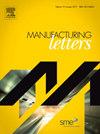砂粒大小对 HydroFlex 动力和性能的影响
IF 1.9
Q3 ENGINEERING, MANUFACTURING
引用次数: 0
摘要
可控、适应性强的内部抛光对于金属添加剂制造 (MAM) 的复杂通道至关重要。传统的流体内抛光方法难以控制材料去除,导致表面粗糙度(Sa)因通道长度、纵横比(AR)和复杂程度而异。HydroFlex 是一种内抛光方法,它通过柔性主轴驱动固定磨料砂轮,在复杂的高纵横比通道中可控、可预测地去除材料。HydroFlex 性能的关键在于砂轮在流体动力和切削力作用下的轨道运动,以实现均匀抛光。实验评估了砂粒大小对轨道运动和相应性能的影响。在转速为 50,000 rpm、槽/轮(C/W)比为 0.54 的条件下,对 46 µm、76 µm 和 91 µm 尺寸的砂粒进行了测试,并对轨道频率和一致性、磨削力、Sa、材料去除率(MRR)和砂轮磨损进行了比较。结果发现,轨道频率与磨粒尺寸的增加直接相关,而在中等磨削力下,轨道的一致性最高。Sa 和 MRR 与 0.15 g/min 和 0.34 g/min 时达到的亚微米粗糙度成反比,对应于 2.2 µm Sa。砂轮磨损受晶粒拉出、损耗和封盖的影响,所有尺寸的磨粒都有类似的磨损。这些研究结果表明,可以通过控制砂轮动力学来控制轨道运动,从而实现对磨削动态的精确控制,这对于在复杂、不均匀的 MAM 通道中实现适应性能至关重要。本文章由计算机程序翻译,如有差异,请以英文原文为准。
Grit size effect on HydroFlex polishing dynamics and performance
Controllable, adaptable internal polishing is critical to metal additive manufactured (MAM) complex channels. Conventional fluid-based internal polishing methods are challenging to control the material removal, resulting in varied surface roughness (Sa) depending on channel length, aspect ratio (AR), and complexity. HydroFlex is an internal polishing method which drives a fixed-abrasive grinding wheel via a flexible spindle to navigate complex, high AR channels controllably and predictably removing material. Key to HydroFlex performance is the orbital motion of the grinding wheel governed by the hydrodynamic and cutting forces to achieve uniform polishing. Effect of grit size on orbital motion, and corresponding performance was experimentally evaluated. 46 µm, 76 µm, and 91 µm grit sizes were tested at a rotational speed of 50,000 rpm and a channel to wheel (C/W) ratio of 0.54 and orbital frequency and consistency, grinding force, Sa, material removal rate (MRR), and wheel wear were compared. Orbital frequency was found to directly correlate with increasing grit size and consistency of orbit shown to be highest at moderate grinding forces. Sa and MRR were inversely proportional with sub-micron roughness achieved at 0.15 g/min and 0.34 g/min corresponding to 2.2 µm Sa. Wheel wear was effected by grain pullout, attrition, and capping with all grit sizes experiencing similar wear. These findings suggest that orbital motion can be controlled through manipulation of wheel kinetics enabling precise control of grinding dynamics essential to adaptable performance in complex, non-uniform MAM channels.
求助全文
通过发布文献求助,成功后即可免费获取论文全文。
去求助
来源期刊

Manufacturing Letters
Engineering-Industrial and Manufacturing Engineering
CiteScore
4.20
自引率
5.10%
发文量
192
审稿时长
60 days
 求助内容:
求助内容: 应助结果提醒方式:
应助结果提醒方式:


